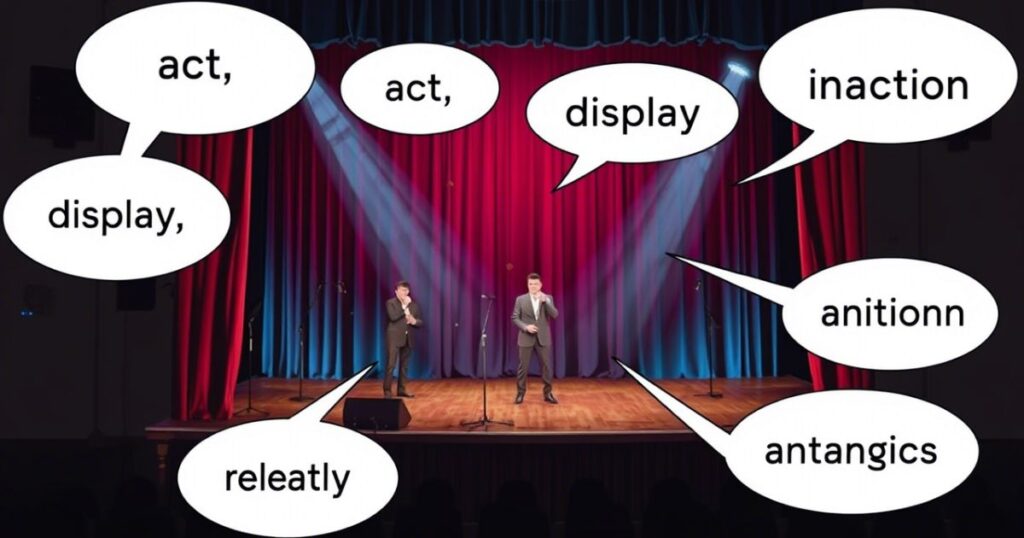When it comes to discussing achievements, understanding the abbreviation for performance is key. An abbreviation for performance is a shortened form of terms used to measure or denote someone’s abilities or accomplishments. Many industries use these abbreviations for performance to simplify communication. For example, the acronym for performance helps professionals express performance metrics quickly without confusion. Knowing the performance abbreviation for specific fields can improve clarity and efficiency.
The personal best abbreviation is commonly used in sports and other performance-driven fields to refer to someone’s highest achievement. When discussing performance, the right abbreviation for performance can make a big difference in how the information is perceived. This is why understanding each abbreviation for performance or acronym for performance can help you better communicate success. Whether it’s a performance abbreviation for a business goal or a personal milestone, these terms are essential for quick, clear communication.
What Is The Abbreviation for “Performance”?

The abbreviation for “performance” can vary depending on the context in which it is used. Commonly, “perf.” is used as a short form in casual or technical settings. It is widely accepted in industries where space is limited, such as in reports, charts, or technical documentation.
In sports or other competitive fields, you may come across the “PB” abbreviation, which stands for “personal best”. While this isn’t a direct abbreviation for “performance,” it refers to an individual’s best performance or achievement in a particular activity or event.
Another term related to performance abbreviation is “acronym for performance,” which can be specific to certain sectors or regions. For instance, in some engineering contexts, the abbreviation “PE” is used to represent performance efficiency.
“Perf.” is also used in the tech and gaming industries to denote performance-related metrics. For example, in video games or software development, it refers to how well a system or player performs under different conditions.
In academic writing, the abbreviation “P” may sometimes be used to represent performance, especially in grading systems or evaluations. This shorthand helps streamline communication, especially in environments where performance assessment is frequent.
What Does “Performance” Actually Mean?
“Performance” refers to how well someone or something accomplishes a task, goal, or objective. It is often used to assess abilities, skills, or output in various contexts, such as work, sports, or art. Performance can be measured in many ways, depending on the field, such as speed, accuracy, quality, or efficiency.
In a professional setting, performance is typically linked to an individual’s work output and how effectively they meet the goals set for them. For instance, a worker’s performance might be evaluated based on the quality and timeliness of their tasks.
In sports, performance refers to an athlete’s abilities during a game or competition, often measured by speed, strength, or points scored. It’s commonly compared to personal bests to track improvement.
In art or entertainment, performance is the execution of a creative work, such as acting in a play, dancing in a recital, or singing at a concert. It focuses on how well the performer brings the piece to life.
Overall, performance is about the execution of a skill or task and the results achieved. It’s a term used to evaluate and understand capabilities in various fields.
Definition, Pronunciation, and Examples
Understanding the term performance is crucial across various fields, as it often serves as a benchmark for success. Whether in business, sports, entertainment, or technology, performance refers to how effectively a task or activity is executed.
It helps evaluate outcomes, skills, and achievements in both professional and personal contexts. Below, we’ll dive into the definition, pronunciation, and examples of performance to give you a clearer understanding of its usage.
Definition:
Definition:
Performance refers to how well a task, activity, or goal is carried out. It can describe the efficiency, effectiveness, or success of an action. Whether in business, sports, arts, or technology, performance measures the result or execution of work.
In business, performance often refers to how well a company meets its objectives or financial targets. For example, a company’s quarterly performance might be assessed by sales growth, profit margins, or customer satisfaction.
In sports, performance is used to evaluate an athlete’s abilities, such as their speed, endurance, or skills during a competition. An athlete’s personal best is often considered their peak performance, representing their highest level of achievement.
Pronunciation:
Performance is pronounced as:
pər-FORM-uhns
IPA: /pərˈfɔːr.məns/
The stress is placed on the second syllable, “form.”
Examples:
- In Business: “The company’s performance this year exceeded expectations, with a significant increase in revenue.”
- In Sports: “Her performance during the 100m sprint was incredible, setting a new national record.”
- In Entertainment: “The actor’s performance in the film was praised for its emotional depth and authenticity.”
- In Technology: “The new software update greatly improved the system’s performance, making it faster and more reliable.”
- In Education: “The student’s performance on the final exam was excellent, earning her the top grade in the class.”
These examples show how performance is used across different fields to evaluate the execution or outcome of actions or activities.
How to Pronounce Performance
Here’s how you pronounce performance: /pərˈfɔːrməns/. If that sounds a bit tricky, let’s break it down:
The word performance is pronounced as:
pər-FORM-uhns
IPA: /pərˈfɔːr.məns/
To break it down:
- The first syllable sounds like “per,” with a soft “uh” sound.
- The second syllable, “FORM,” is emphasized and sounds like the word “form.”
- The last syllable is “uhns,” pronounced quickly and softly.
When saying performance, remember to emphasize the second syllable (“FORM”) and keep the other syllables more subtle.
Examples:
Let’s look at some examples to see how we can use performance and its abbreviation in context:
- Complete form: “The team’s performance this season has been outstanding!”
- Abbreviation: “We need to assess the Perf. of our new marketing strategy.”
See how easy it is? Using Perf. instead of performance makes writing more concise, especially in lengthy reports or data analysis.
Short Abbreviation for Performance
The short abbreviation for performance is commonly “Perf.” This abbreviation is widely used in contexts where space is limited, such as reports, charts, or quick notes, making communication more efficient.
The Importance of Context
Context is essential when using abbreviations like “Perf.” for performance. It helps ensure clarity, as the abbreviation could mean different things in various settings. In business, it may refer to financial results, while in sports, it could describe an athlete’s achievements.
Understanding the context helps avoid confusion, ensuring that “Perf.” is interpreted correctly in reports, presentations, or any other communication. It ensures precise and efficient communication across industries.
Acronym for Performance
An acronym for performance is “PFX”, commonly used in specific fields like entertainment or technology. This shortened form helps streamline communication, especially in contexts that require frequent reference to performance metrics, such as reports or data analysis.
Another widely used acronym is “PF”. It’s often seen in business or technical discussions, where performance assessments are frequently mentioned. As with any acronym, it’s essential to clarify its meaning within the given context to avoid confusion.
Performance Related Acronyms
There are several performance-related acronyms used across different industries to streamline communication. One example is PFX, commonly used in entertainment or technology to represent performance in a more concise form. It’s typically used in reports or technical discussions where performance metrics are frequently evaluated.
Another common acronym is PF, often used in business and project management contexts. This abbreviation refers to performance factors or performance feedback, helping professionals quickly assess and communicate performance levels without lengthy explanations. As with all acronyms, context is crucial to ensure clear understanding.
Related Guide:
35 Synonyms & Antonyms for Social Media
Examples of “Performance” in Context
Understanding how performance is applied in different fields can help clarify its meaning. Below are some examples that demonstrate how performance is used in business, sports, entertainment, and more.
Each example shows how performance is evaluated or referenced in real-life situations.
- In Business: “The company’s performance over the last quarter exceeded expectations, with a 15% increase in profits.”
- In Sports: “Her performance at the championship was outstanding, earning her a gold medal.”
- In Entertainment: “The actor’s performance in the play received rave reviews from both critics and the audience.”
- In Education: “The student’s performance on the final exam showed significant improvement compared to earlier tests.”
- In Technology: “The new update greatly enhanced the app’s performance, making it faster and more reliable.”
These examples illustrate how performance is used in various contexts to evaluate success, skill, or results.
How This Makes Communication Easier
Using abbreviations like “Perf.” or acronyms such as “PF” for performance makes communication more efficient, especially in industries where space and time are limited. These shortcuts allow for faster writing and easier understanding, particularly in reports, emails, or presentations where the same term is repeated often.
How Do You Pronounce “Performance”?
The word performance is pronounced as:pər-FORM-uhns
IPA: /pərˈfɔːr.məns/
To break it down:
- The first syllable sounds like “per” with a soft “uh” sound.
- The second syllable, “FORM,” is stressed and pronounced like the word “form.”
- The final syllable sounds like “uhns,” pronounced quickly and lightly.
Just remember to emphasize the second syllable, “FORM”, when pronouncing performance.
Synonyms and Antonyms for “Performance”

Understanding the synonyms and antonyms of performance helps to better grasp its meaning and usage in different contexts.
Synonyms can offer alternative ways to describe performance, while antonyms highlight its opposite, giving a fuller perspective. Here are some common synonyms and antonyms for performance.
Synonyms for Performance:
- Achievement
- Execution
- Accomplishment
- Outcome
- Result
- Display
- Show
- Action
- Work
- Effort
Antonyms for Performance:
- Failure
- Incompetence
- Underachievement
- Inefficiency
- Deficiency
- Neglect
- Shortcoming
- Mistake
- Error
These synonyms and antonyms help provide a broader understanding of performance and how it can be applied or contrasted in different contexts.
The History of The Word Abbreviation for Performance
The use of abbreviations dates back centuries, as people sought to simplify communication, especially in writing. The abbreviation “Perf.” for performance likely emerged as a shorthand in professional fields like business, sports, and entertainment, where quick, efficient communication was essential. This allowed writers and speakers to convey ideas without the need for lengthy explanations.
In the early days, abbreviations like “Perf.” were used primarily in handwritten forms, such as notes or reports. As technology advanced, these shortened forms became more standardized, especially in industries with technical writing and reporting, making it easier to express concepts in a compact format.
Today, “Perf.” is widely accepted in various industries, helping streamline communication in data charts, performance reviews, and technical documents. Its evolution highlights the continuous need for efficiency in language and communication.
When Should You Use the Abbreviation for “Performance”?
We’ve explored the definition, pronunciation, and history of the word “performance,” but what about the use of its abbreviation? When is it suitable to shorten this term?
There isn’t a universally standard abbreviation for performance, though you’ll often see “perf.” or “prefs” (for plural) used in specific contexts such as:
- Technical writing
- Scientific reporting
- Performance evaluations
- Business presentations and reports
- Academic research papers
The key point to remember is that abbreviations should be used sparingly and only when they’re widely recognized by your intended audience. While abbreviations can be time-savers, they shouldn’t compromise clarity.
In everyday writing or casual communication, it’s generally better to use the full word “performance” to avoid any confusion. Ultimately, the goal is clear and effective communication, so always ensure your audience will easily understand the shortened form.
Personal Reflection: Why Abbreviations Matter

Abbreviations serve a practical purpose in communication, especially when trying to convey information efficiently. In my experience, using abbreviations like “perf.” for performance can make writing more concise without losing meaning. It’s a valuable tool in professional settings where time is often limited, such as in reports or presentations.
I’ve found that in industries like business, technology, and sports, abbreviations help streamline communication. For instance, when discussing performance metrics or results, using “perf.” allows for faster reading and easier understanding of key points. This is particularly important when dealing with large amounts of data or when you’re on a tight deadline.
However, there’s also a balance to strike. While abbreviations are helpful, they can become a hindrance if overused or misapplied. I’ve seen situations where excessive abbreviations leave people confused, especially if the audience isn’t familiar with the shortened terms. In those cases, it’s better to stick to the full word.
That said, knowing when and where to use abbreviations is key. In formal writing or when addressing a broad audience, it’s often safer to spell out the full word. “Performance” may not always need to be shortened, especially in casual or informal writing. The goal is always clarity, and abbreviations should never hinder understanding.
On a personal level, I appreciate how abbreviations make it easier to focus on the most important information. When writing long reports or emails, they allow me to communicate the essence without bogging down the message with repetition. This way, I can maintain a professional tone while still making my points clear and succinct.
Ultimately, abbreviations like “perf.” aren’t just time-saving they’re about making the message more accessible. As long as they’re used thoughtfully and appropriately, they enhance communication and help people process information faster.
FAQ’s
What is an abbreviation for performance?
The abbreviation for performance is often shortened to perf. It helps to communicate more efficiently in reports or documents, making things clearer and quicker to read.
What is the definition of a performance?
Performance refers to how well someone or something does a task. The abbreviation for performance can be used in many contexts to simplify communication about how tasks are executed.
What does perf stand for?
Perf is the short form for performance. The abbreviation for performance is widely used in various industries, such as business and sports, to describe how well something is done.
What does perf slang mean?
In slang, perf can refer to something excellent or perfect. The abbreviation for performance is often used to describe something that is impressive or of high quality.
What is the abbreviation for performance evaluation?
The abbreviation for performance evaluation is usually perf eval. This shortened form makes it easier to refer to the review of someone’s performance in work or sports.
Conclusion
The abbreviation for performance plays a crucial role in simplifying communication, especially in fields like sports, business, and education. Whether you’re tracking results or summarizing achievements, using an abbreviation for performance ensures clarity and efficiency. Commonly used, the acronym for performance helps express complex ideas with ease. A common example is the personal best abbreviation, often used in sports to denote an athlete’s top performance.
The performance abbreviation serves not only to save time but also to streamline reporting and analysis. By using an abbreviation for performance, professionals and enthusiasts can focus more on the results rather than lengthy explanations. So, next time you’re discussing goals or progress, consider using the abbreviation for performance for quick and effective communication. Embracing these terms like acronym for performance and performance abbreviation can help improve understanding and keep things concise across various fields.

Atlas Reid is an experienced administrator with 5 years of expertise in managing operations, streamlining processes, and ensuring efficiency. Skilled in leadership, organization, and problem-solving to drive business success.








